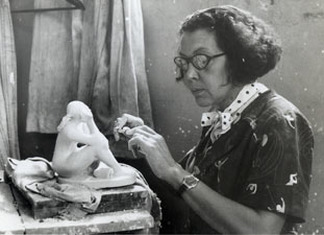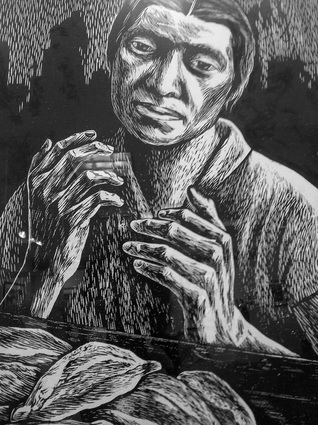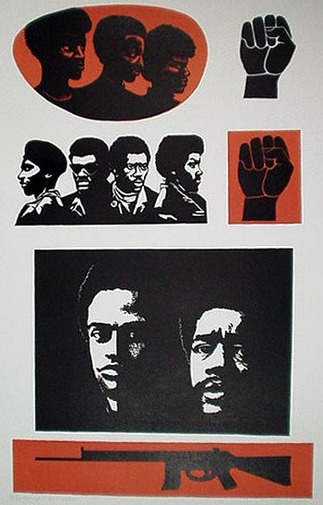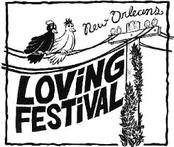Was Elizabeth Catlett ever afraid? Her sculpture and prints currently on exhibit at Stella Jones Gallery in New Orleans (through July 30th) roar with fearless conviction and creative genius. Yet I know that as a black woman artist, Catlett faced the incredible obstacles of institutionalized racism and sexism on personal and professional levels. Her accomplished, prolific archive seems to shrug in defiance, “And?” This terrific retrospective deserves great attention, as does the story of her radical, adventurous life; I will scratch the surface in the hopes that you’ll be inspired to delve deeper.
| | “Bread, or The Right to Eat” (1952, linocut) perfectly exemplifies the humanist style and socialist agenda of Catlett’s oeuvre. The content is simple: a black woman stands behind a platter of bread. Yet Catlett’s emphasis on the woman’s strong, aching hands and yearning face imbues her subject with intimacy – this isn’t an idea of hunger but an experience of it. By filling the entire frame with her subject’s body, facing forward with direct intensity, Catlett personalizes this woman’s plight, and demands we engage with it. The bread becomes secondary to the human connection we all need in order to survive. In the tradition of the political Mexican artists she was inspired by, Catlett raises her subject to a noble position: look, here’s a hungry woman, she’s worthy of our respect, she’s your family, do you recognize her? The effect is bracing and indicative of Catlett’s overall approach, from depictions of mothers and their children to the Black Panthers and beyond. Catlett’s figurative style, minimalist and elegant, pares her gestures down to their pure essence; there’s no fuss to her surface, no noise in her space – it’s a smart technique that quiets the mind and focuses the eye. Spend enough time with the clean, unsentimental lines and repeating motifs of her print work and they begin to feel like musical scores, creating songs of a transcendental nature. Take “Homage To The Panthers” (1970, color lithograph), for example. Catlett’s crisp aesthetics suggest that the faces, fists and guns of resistance are the notes in a mighty hymnal. The resulting song that resonated in me, standing in front of “Malcolm X Speaks For Us” (1969, linocut) was emotional and uplifting, feeling like the spirituals we sing in my church: oppressed people can unite, in the uniting we fight, in the fighting there’s great beauty, in the beauty is a power much greater than we, and it’s free. Alongside this incredible collection of prints, Catlett’s sculpture stands as some of the 20th century’s most potent work in the field. The regal grace of “Seated Mother and Child” (undated, bronze), “Triangle Woman” (undated, black marble) and “Reclining Woman” (undated, bronze/wood) beautifully marry Catlett’s fierce power as a sculptor with her recurring feminist themes. These strong women are not to be trifled with; these are the women who run the world. And in a world that continually denigrates women, particularly women of color, this message remains vital. After you’ve experienced her work at Stella Jones, I suggest a visit to Catlett’s massive bronze sculpture of Mahalia Jackson in Congo Square. If you’ve any doubts regarding her mastery of the form or her opinions regarding black female power, this sculpture will silence them. Catlett devoted her life to telling the stories of her people – the lovers, fighters and workers of the world that the white men with the keys to the “kingdom” try to deny entry to. That exclusion has horrible consequences, a fundamental one being that people on “the outside” can get to thinking they just don’t matter. Yet there Elizabeth Catlett was – creating, celebrating, teaching, bravely refusing to acquiesce to a system that would negate her and her |
community, insisting that there’s another, more inclusive world to occupy. There’s a mythic heroism to artists who truly believe that art is a tool that can effect social change and that they have a responsibility to serve. Elizabeth Catlett is one of the grand warriors in the tradition whose work continues to sing, “Forge on! Do not falter! You are not alone.”
- Elizabeth Underwood
- Elizabeth Underwood
(A note regarding Stella Jones Gallery: they’ve done a fantastic job organizing and hanging this powerful exhibition. I’m grateful for their hard work and devotion to representing artists that continue to be ignored by mainstream institutions. I cannot think of a better environment to get to know Elizabeth Catlett’s work in, or a staff better equipped to insure that her legacy lives on.)
http://stellajonesgallery.com
https://en.wikipedia.org/wiki/Elizabeth_Catlett
www.banderasnews.com/0512/art-elizabethcatlett.htm
http://stellajonesgallery.com
https://en.wikipedia.org/wiki/Elizabeth_Catlett
www.banderasnews.com/0512/art-elizabethcatlett.htm




 RSS Feed
RSS Feed